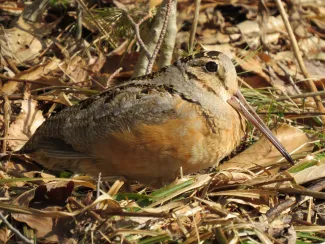For many species of wildlife, daily survival requires a careful balance of avoiding detection from predators and attracting attention while foraging or charming potential mates. When a prey species flees from a predator, it taps into hard-earned energy reserves, is not able to feed, secure a mate or defend young; and may even expose itself to another predator or risk. Conversely, when a predator pursues a prey species, it expends a large amount of energy during the chase, can be significantly injured by its prey, and may be leaving its young exposed or undefended. Simply put, survival comes at an expense.
Blending In, Standing Out
One of the least expensive survival techniques animals can employ is the use of their coloration as a defense. Various color adaptations allow animals to hide, warn predators away, and even be misidentified for more threatening species. The American woodcock, a plump shorebird with a long probing bill, is a relatively slow flyer. This weakness can make woodcocks easy prey, so the species compensates by being very difficult to find. Woodcocks use black barring on the head and neck in conjunction with chestnut, brown, buff, black, gray and silver mottling on the body to virtually disappear into leaf litter. This defense mechanism is very effective; the American woodcock is rarely seen until flushed. When a predator approaches too closely, the woodcock hurtles itself into the air, lands a short distance away and fades into the new location.

In addition to the American woodcock, the American bittern, copperhead, and a number of other species are able to blend into their surrounding habitat to avoid detection.
Other animals use boldly contrasting patterns to warn predators away. This patterning is often referred to as aposematic coloration. The American badger, a strong and ferocious hunter of prairie dogs, ground squirrels and gophers, may use alternating black and white coloration on its head to remind potential predators of past hostile encounters. Though the badger is capable of defending itself against confrontation, combat is energetically expensive. Instead of repeatedly going into battle, the badger may allow its head coloration to dissuade potential threats so it can spend more time hunting its prey.

Similarly, the striped skunk’s black and white coloration warns potential predators of its long-lasting pungent defense mechanism. While the coloration may not be a foolproof defense, it can serve as an initial warning, allowing the badger and skunk to reserve more costly mechanisms for more serious threats.
Other animals masquerade as more dangerous species. For example, many butterflies and moths have large spots or “eyes” on their wings. Though simple, this appears to be an effective defense. Predators mistake the insects for larger animals that may take more energy to pursue. The butterfly group is better known for another form of mimicry. The viceroy butterfly, a harmless insect, mimics the appearance of the monarch butterfly, which has a foul taste. When a harmless species mimics a harmful one, it is called a Batesian mimic. Some biologists contend the viceroy is distasteful as well; when two harmful species resemble each other, it is called Müllerian mimicry.
Mimicry isn’t limited to the butterfly group. Some harmless snakes such as the black rat snake will move their tails under leaf litter, mimicking the sound of a rattlesnake. Another Oklahoma mimic is the hognose snake. When threatened, the snake will flatten its head and raise the upper part of its body, appearing like a cobra. If mimicking a cobra doesn’t work, the docile hognose will overturn and “play dead.”
Tails and Quills
Some animals expend more energy when defending against predation. Like many other lizards, the Great Plains skink will actually sever its own tail to escape from a predator. When severely threatened, the tail muscles separate at pre-weakened planes, as do the vertebrae. Blood vessels in the remaining tail contract immediately after the separation, limiting blood loss. Many times, these tails are very colorful, and the recently detached muscles still contract and expand, distracting the predator long enough to allow the tailless lizard to bolt under nearby escape cover. While valuable, this defense mechanism is very expensive. Fat reserves, vital for survival, are left behind in the severed tail. Additionally, if the colorful tail plays an important role in attracting mates, the tailless lizard may not be as appealing and may lose mating opportunities.

The North American porcupine has a more aggressive defense mechanism. Specialized quills located on the back, sides and tail have overlapping scales or barbs that penetrate the attacking animal. Contrary to popular belief, these barbs do not shoot from the tail but are easily detached when touched. A single porcupine may have as many as 30,000 quills. Though the porcupine will not lose all of its quills during an attack, this is a costly defense, as the porcupine will use energy resources to regrow quills that would otherwise be used to store fat reserves.
Daily survival is a complicated and expensive endeavor for many of Oklahoma’s wildlife. In order for the species to survive, clever and unique adaptations and behaviors are a must. Whether exploiting cryptic coloration, mimicking more dangerous species, using quills or spines as a deterrent, or using a combination of defense mechanisms, individual animals must balance the energy required to develop or use defense mechanisms with costs associated with securing food and fat reserves and attracting mates.